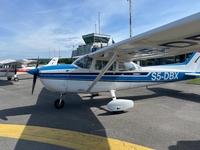 runway. Half-jokingly, I asked the 20-something pilot if he had had any before the flight. Well, of course not, thankfully.
runway. Half-jokingly, I asked the 20-something pilot if he had had any before the flight. Well, of course not, thankfully.
We took off the short runway on a sunny morning with almost zero wind. I was sitting next to the pilot, with Bordeaux enologist Nicolas Vivas and Boštjan Zidar, chief winemaker of Vinakoper, in the rear seats. When the plane shook occasionally as we flew over a hill, the pilot asked me “Are you okay?” as I had admitted to some nervousness. But it was exhilarating to see vines from above – vines that we had visited the day before – on the ground,  during what turned out to be one of the most memorable wine media trips I can recall.
during what turned out to be one of the most memorable wine media trips I can recall.
Nicolas Vivas is a specialist on red wine polyphenols and tannins who consults for estates in Bordeaux and abroad since 1986. I had met him some 20 years ago during one of my many visits to Bordeaux, and he generously invited me to the Vinakoper estate, which had been founded back in 1947. Over the last three years, Vivas has been working with the estate team to craft wine from a specific sloped vineyard located near the Istrian coastline, within view of Trieste, Italy. “The moment I saw this vineyard, I thought that great wine can be made here,” Vivas told me.
After meeting Zidar and some of his team over a glass of Charmat-method rosé bubbly, we enjoyed an initial dinner with some fine wines crafted at this estate, which was established back in 1947.
In working with Vinakoper, Vivas became especially pleased with the indigenous Refošk grape. As I had recently published in Decanter magazine, the Bordeaux enologist calls it “excellent for climate change,” and he recommends it for planting in Bordeaux, to counter the sensation of overripe Merlot that has become common on the Right Bank. “All you need in a blend is about two to three percent of Refošk,” he told me.
The dark-skinned variety, known for its tannin and high acidity, goes by the name Refosco in northeastern Italy. It originates from an ancient group of related red grapes long grown in northern Italy’s Friuli-Venezia Giulia, western Slovenia, and the Istrian Peninsula of Croatia.
Vinakoper is a sprawling estate with 583 hectares under vine, mostly with the white Malvasia and Refošk grapevines, plus olive trees. It celebrated its 70th anniversary in 2017, including major renovations. While the estate may carry too many brands at the moment, Zidar told me, I was impressed their dry whites and reds and especially their excellent, traditional method sparkler, the Capris Grand Cuvée (Slovenska 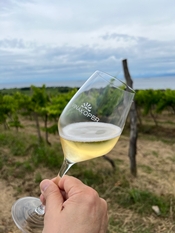 Istra), a blend of 80% Pinot Noir and 20% Chardonnay, disgorged after 24 months in bottle.
Istra), a blend of 80% Pinot Noir and 20% Chardonnay, disgorged after 24 months in bottle.
During the Tito era, when Slovenia was part of Yugoslavia, Vinakoper wines were consumed in the home country but also exported to Italy, West and East Germany, Austria, Czechoslovakia, and Poland. That was good, but quantity was prioritized above quality. Tasting recent vintages of Vinakoper Refošk as compared to older wines illustrates what Zidar said to me during the visit: “Some 30-40 years ago, the grape was too acidic with raw tannins, but by the 1990s, we focused more on supple tannins and careful extractions.”
One of the best wines I tried for example was the Capo d’Istria Refošk 2020 vintage “Limited Edition,” which was aged in 30% new oak. Coming from a relatively cooler vintage, it conveys a northern Rhône Syrah-like bacon and pepper aspect with crushed mint (a common taste from Refošk, I have come to understand), along with juiciness and remarkable freshness on the finish. It was made from many vines grown in that special vineyard that caught Vivas’ attention. And it proved even better than the 1999 vintage, which had been awarded “Champion of Red Wines” at the Ljubljana Wine Competition.
Vivas has worked with Vinakoper to introduce a kind of Super Tuscan to Slovenia, and over dinner at the estate restaurant, he tried to illustrate his point.
Named Kogo, which means “cook” in Istrian dialect, the restaurant features both 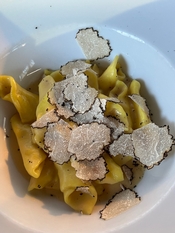 Istrian and international cuisine, but we focused on local delicacies – from deer (and bear!) sausage to fresh Adriatic scampi, by way of homemade Istrian Fuži pasta (crafted from flour and eggs) with superlative truffle shavings and wild asparagus with cuttlefish, among many other delicacies. These included delicious local cheeses, like 24-month aged Tolminc, a hard cow’s milk cheese that takes its name from the city of Tolmin, situated in the Isonzo Valley.
Istrian and international cuisine, but we focused on local delicacies – from deer (and bear!) sausage to fresh Adriatic scampi, by way of homemade Istrian Fuži pasta (crafted from flour and eggs) with superlative truffle shavings and wild asparagus with cuttlefish, among many other delicacies. These included delicious local cheeses, like 24-month aged Tolminc, a hard cow’s milk cheese that takes its name from the city of Tolmin, situated in the Isonzo Valley.
Thoroughly enjoying fine cuisine, we tried several wines spanning over 45 years, all coming from that sloping vineyard that Vivas noticed before accepting his consultant job. For example, Zidar uncorked a 1979 Cabernet Sauvignon crafted from vines on that slope, that clocked in at 12.5% alcohol. The color was brick red, 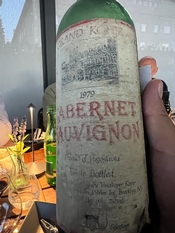 and the taste balsamic and grassy, with desiccated leaf forest floor character making it seem very rustic. It had some power, but it was a wine rather past due.
and the taste balsamic and grassy, with desiccated leaf forest floor character making it seem very rustic. It had some power, but it was a wine rather past due.
By comparison the 1989 Cabernet Sauvignon – at 12.5% alcohol – exuded wet stone, creosote, and some crushed tobacco, with greater palate density, even if the tannins proved still downright rustic and the finish somewhat abrupt.
Fast forward 20 years, and the 2009 Cabernet Sauvignon (at 14% alcohol) from the same vineyard showed more depth than the two preceding wines, exhibiting eucalyptus-like freshness and clearly better-quality tannins.
This vertical tasting clearly showed how the estate has been improving viticulture 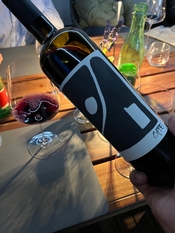 and winemaking over the years, and it culminated in that brand-new wine that Vivas helped to craft, aptly called Cape. This 2022 vintage blend includes Syrah, Cabernet Sauvignon, Cabernet Franc, Merlot and Refošk. It is the first wine to be made with the assistance of Vivas, and shows the potential of what can be done at this estate. With production quantity of just under 2,600 bottles, the wine exudes notes recalling suave blue fruit, blackberry, creosote and subtle wet stone. The palate has a strong attack, with at first somewhat tight tannin, but of excellent, age-worthy quality with a fresh, minty finish.
and winemaking over the years, and it culminated in that brand-new wine that Vivas helped to craft, aptly called Cape. This 2022 vintage blend includes Syrah, Cabernet Sauvignon, Cabernet Franc, Merlot and Refošk. It is the first wine to be made with the assistance of Vivas, and shows the potential of what can be done at this estate. With production quantity of just under 2,600 bottles, the wine exudes notes recalling suave blue fruit, blackberry, creosote and subtle wet stone. The palate has a strong attack, with at first somewhat tight tannin, but of excellent, age-worthy quality with a fresh, minty finish.
The parallel to a Super Tuscan is reinforced to me by Vivas’ flair and panache, having hired highly respected Paris-based artist Pierre Emmanuel Martin to design the label for the new wine, which tastefully illustrates the cape vineyard and a wine grape.
Any visit to the region would not be complete without culture as well as cuisine, so my 2.5-day visit included a look at the Koper village library of historical books, where you need to wear gloves to leaf through fragile yet gorgeous tomes meticulously made long ago, such as a 13th century parchment made from the skin of sheep indicating Franciscan rules of behavior, or a 1453 edition of the Book of Psalms. I learned that none other than Justinian the Great established the city, which had been called Justinopolis. Other worthy sites include the 15th century Praetorian Palace and Loggia in a Venetian Gothic style and the 12th century Carmine Rotunda church.
We also visited the gorgeous seaside village of Piran, lined with some very good restaurants. It is one of the three major towns of Slovenian Istria, which counts but 42 kilometers of coastline. You cannot help but admire the medieval architecture and narrow streets with plenty of attractive shops. Trust me on that, and experience this delightful place if you can.
